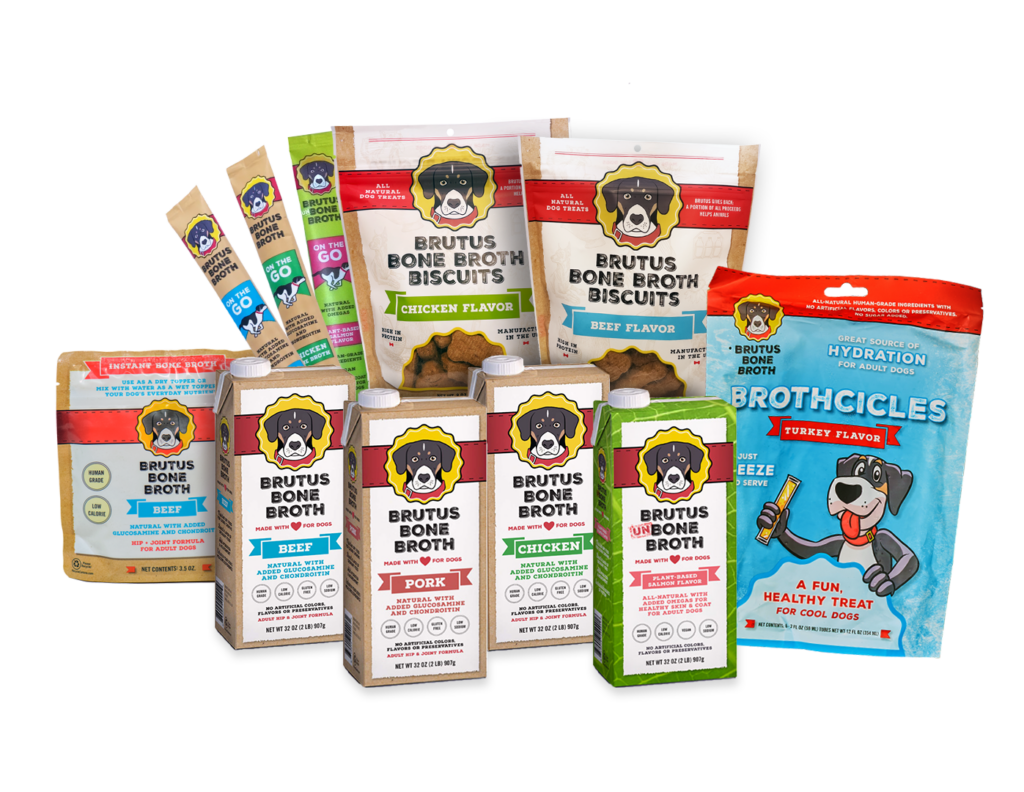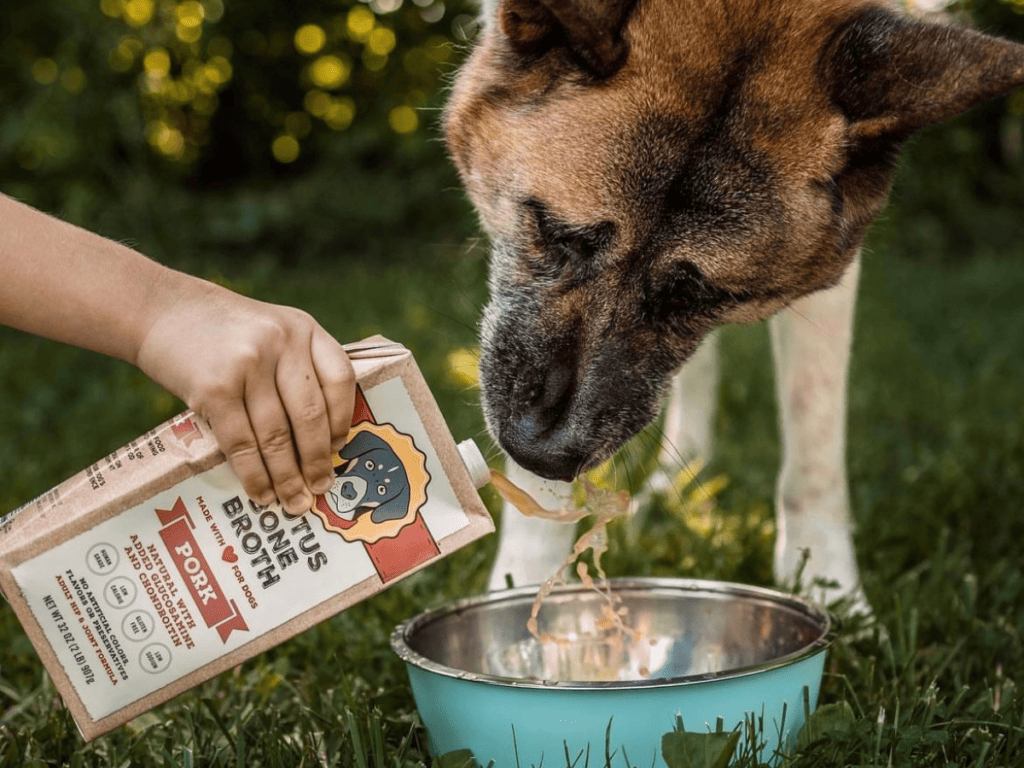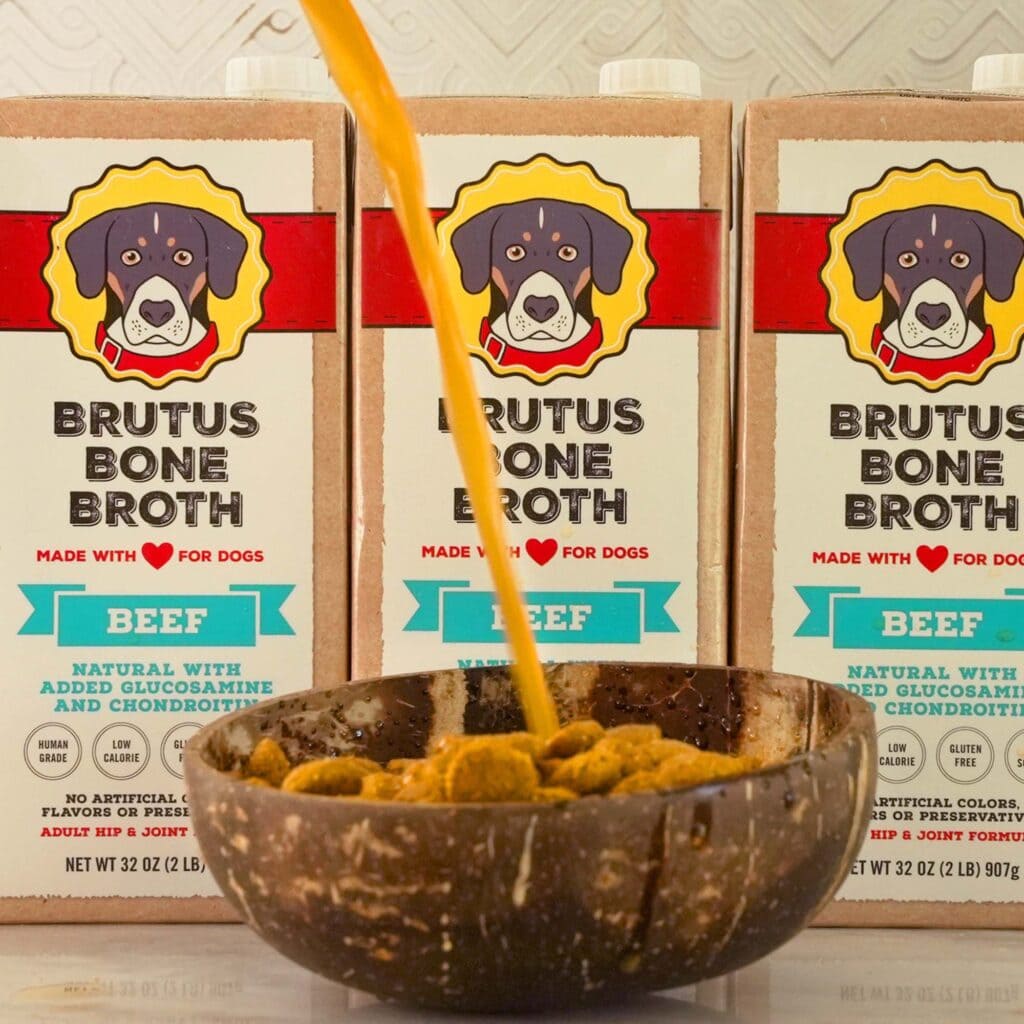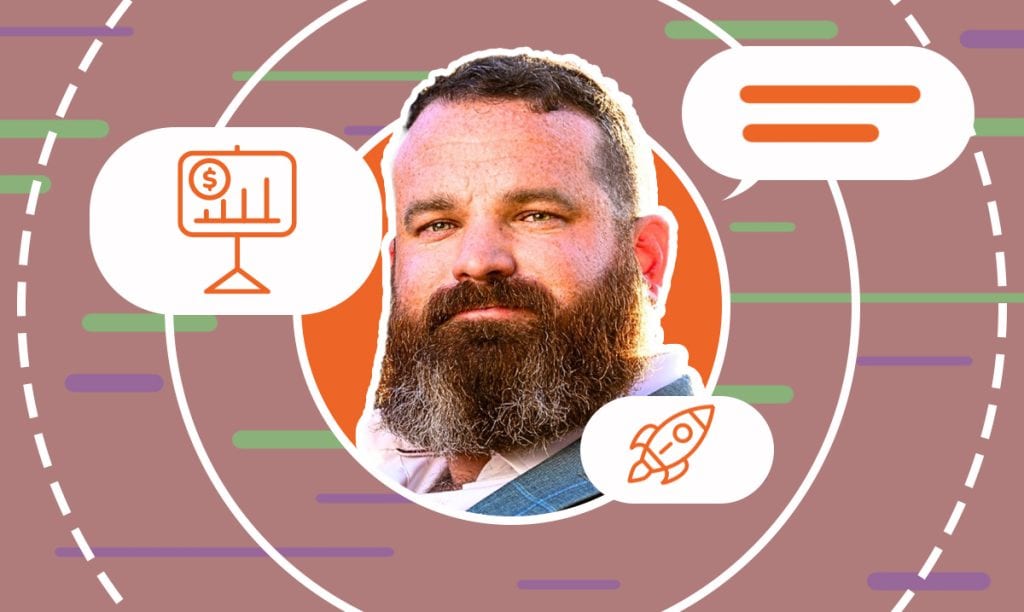Meet Vadim Bozhko, the visionary behind Bozh Studio — a branding and web design business dedicated to helping service-based companies stand out.Fu ...
The Bark and the Bite: Building a Business in Dog Nutrition
Written by: Carolyn Young
Carolyn Young is a business writer who focuses on entrepreneurial concepts and the business formation. She has over 25 years of experience in business roles, and has authored several entrepreneurship textbooks.
Published on December 15, 2023

Brutus Broth Inc, co-founded by the visionary Kim Hehir, has swiftly carved a niche for itself with its unique line of health-centric bone broths and biscuits for dogs. Our interview with Kim delves into the origins of this remarkable journey, exploring the challenges faced, the triumphs celebrated, and the collaborative spirit of her team. We also gain insight into their effective marketing strategies and the ambitious future goals that drive this pet wellness pioneer. Join us as we uncover the story behind Brutus Broth, a brand that is not just a product, but a testament to the love and care for our canine companions.
Origin Story: Motivation Behind the Business
SBS – What motivated you to start the business, and what is the story behind it?
Kim – I have a very strange business background. I went to the Cornell University School of Hotel Administration and started my career as an environmental consultant specializing in hotels. I traveled around the world working with everyone from hotel owners to governments, developing sustainable tourism policies, working with the United Nations on their sustainable development goals, the Olympic Committee, etc. I rebuilt the hotel portion (it was Hilton at the time) of the World Trade Center after the first bombing.
Then, I made a career switch. I went into investment banking and private equity. I was doing more marketing on the investment banking side, and on the private equity side, I was an investment analyst. No matter what job you have, you need to understand finance because unless you know money, you will never get far.
I took a step back when I took that job as an investment analyst. I was pretty high up on the marketing side, but I didn’t have the experience, and I hated that job in some ways because it was boring for me. I’d sit in a cubicle doing spreadsheets all day, but I knew I needed to learn it to get to the next place. I always equated it to algebra — no one likes taking it, but you need it to graduate from high school.
From there, I became the head of strategy for Leading Hotels of the World, a luxury hotel company. At the time, they had 500 hotels in 90 countries. I loved my job. I was there for almost 10 years, working as the CEO’s right-hand person. When I joined, the company was not making any money, so I was helping him turn it around and leverage the brand and other things. My job was different every week, so that was fun. I learned how to run a business. I was responsible for all their new business launches, brand extensions, and everything. That allowed me to get a lot of good experience from a practical business standpoint.
Then, I took a little break because my husband and I traveled a lot for our jobs. My husband’s in private equity, and we had two kids we never saw. I had my first child while on a business trip, so it gives you an idea of how much I travel. At that point, we were living in New York City, and my kids were two and three or three and four when I stopped working. Being in New York and not having the job I used to have was hard because everyone asked me what I would do next. Different companies were calling and asking me to join them.
At the time, I was burnt out and needed to refocus on my kids. My husband said, “Since you’re not working right now and we were in New York City for your job, why don’t we move to Hawaii?” He was commuting between New York and Tokyo, so Hawaii was halfway, and he had an office there too. So, I said, “All right, let’s try it for two years.” I was in a rut and thought it would be a nice adventure. The kids were still little when we moved to Honolulu, and we spent 13 years there. We just left two months ago. I’m really sad, but it was becoming less and less practical. My kids are both at school on the East Coast, and it was too remote.
I’m a type A personality, so I joined many different nonprofit boards in Hawaii. I didn’t know anyone, so that allowed me to volunteer and keep my mind moving. If I had to be there for my children or my son was sick, for example, I didn’t have the pressure. That was great for a while, but I was getting restless.
In 2016, exactly this time of year, my father had been diagnosed with cancer. My dad was a lifelong entrepreneur; he owned his own mechanical contracting business, but he sold a majority piece to his business partner and gave up the day-to-day because he had to undergo treatment. He was getting frustrated.
My sister Sue came to me and said she was talking to our brother Tom (I’m the oldest, Tom’s the second, and then there’s Sue and her twin), who spent Thanksgiving with her and our parents in Connecticut. Tom told her, “No offense, but how is your dog Brutus still alive?”
My sister had adopted this rescue dog named Brutus from a high-kill shelter. At the time, he had no fur and was skinny. He was abused, and she nursed him back to health. She always says she did it with love and grandma’s bone broth. It was a bone broth that my mom would always make, similar to a chicken soup your mom makes when you’re sick. It was her recipe. Sue would pour it on the dog’s food. A dog that size usually lives until they’re about eight or nine years old. At the time when Tom was asking, he was 12 years old and 135 pounds.
Sue told Tom that everyone, including her vet, always asks what she feeds him because he’s super active, healthy, and has lived way beyond his years. When she said it was this bone broth, he asked where she bought it. Sue said she had looked everywhere and found one very high-end pet boutique that carried a bone broth, but it was in the back freezer and looked disgusting and very expensive — so she just made it. Tom knew it would take two days to make, but Sue made it in big batches and froze it. Then Tom suggested she bring it to market if everyone asks what she feeds your dog and you can’t find it anywhere. She said, “I don’t know,” but Tom said, “Call Kim. She needs something to do.”
She called me and asked if I’d be interested. I said, “I’ve been looking to do something. I don’t know anything about the pet industry, but I know about business. Let me research and see what the opportunity is, and I’ll get back to you.”
My sister had a manufacturing background because, before this venture, she was a partner in a dairy company, but it flopped and went bankrupt. So, I did the research. I found a lot of information that the pet industry was booming and was somewhat recession-proof. It was also highly fragmented. You had many mom-and-pops with really cool artisanal products, but they couldn’t scale, or you had Purina, and there was this big white space in between.
We saw that grocery stores were starting to innovate. It used to be that you could only get gourmet snacks, for example, at Dean & DeLuca, but now you can get it at Wegmans. So, grocery stores were looking to bring in exciting products — and pet trends always follow human trends. We knew what was happening in the human food space; bone broth was becoming very popular, but there was nothing like that in the pet space.
Now we have what’s called the humanization of pets, where people want to treat their pets like their kids, so there was a big trend of people wanting to feed their dogs like they feed themselves, and more people looking at the health of dog food. Foot traffic in grocery stores is much higher than in a pet boutique. We would have to, let’s say, sell one case to a pet boutique, but we could sell an entire pallet to a grocery store. So, from an efficiency standpoint, we decided there was an opportunity and wanted to position ourselves more as a mass market than a boutique. It was for various reasons, mainly scalability, efficiencies, and that kind of thing.
We found a manufacturer to help us commercially make the bone broth. We partnered with a company whose half of the business is restaurants and hotels, and the other half is hunger relief. They make nutrient-rich broths for starving people in third-world countries. That’s our competitive advantage — we infuse supplements for functional health into our bone broth, so it’s not just a soup. It’s actually a super-food. It’s very difficult to do that without changing the flavor profile and without having sediment, so it’s a science experiment to figure out.
We also got a co-packer who was a big human food co-packer. We go through several rounds of quality assurance because we’re human-grade. We also go through AAFCO regulations (animal and pet food) that vary from state to state. Ironically, it’s harder to be a pet food than a human food manufacturer.
Also, in my experience, whatever you write in the business plan never comes true, so we decided to beta test. We got Wegmans Food Markets and Big Y Supermarkets to sign on as beta test partners. It’s two different demographics, both in the Northeast (and we were co-packing our bone broth in the Northeast and had a warehouse in New York).
Through testing, we found a lot of information. It was six to nine months of testing and moving the product to different locations within the aisle. First, we thought people would pour this on dry food, so we put it with the dry food. Then we found it was a treat, too, so we put it in the treat area. Then, many people buying our product usually bought premium wet food to mix with the dry food, so we put our broth in the wet food section.

Early Challenges and Managing Remote Operations
SBS – Can you tell me what were the first challenges you faced? How did you manage your business when you were in Hawaii and your sister Sue was in the US?
Kim – Sure. I think the number one thing for us is to do the research. We did the research and the beta test. We didn’t know it was going to work. Also, because we didn’t have much money, we needed to mitigate our risk, so everything was outsourced. Right now, we’re looking at acquiring a small company, and many people we talked to (who are in that space) spent all their money on marketing agencies to do branding concepts and focus groups. We didn’t have the money to do that. All around, many people said “no.”
You have to have the story and the data to back it up. People want to buy into the dream. You can’t just say, “I thought this would be a good business idea.” There has to be something more! We wanted our company to be a mission-based company with a purpose. Our mission is to nourish your pet while giving back to the community, so we partnered with some animal shelters. We have a kids’ committee to teach kids about entrepreneurship and philanthropy.
When we did our first production run, we bought all of our packaging and based it on what the research showed the packaging was supposed to say. However, AAFCO, as I mentioned earlier, is regulated state by state, and every state wants you to state different things on your packaging. We had one call-out on our packaging that said “with glucosamine” (because we fortified our product with glucosamine), and one of the states’ regulations indicated we had to change it. We had already printed and manufactured the packaging, so we didn’t know what to do. If we threw it out and started all over, it would take about three months to get the packaging, and then we’d have to get line time because we’re co-packing, and we don’t own a factory… So, we made stickers with one of our charities and said, “Proceeds will help benefit this charity,” and put it over the “with glucosamine” line. It was a solution that saved us time and money, even though we were in the warehouse putting stickers over everything.
By the way, we found out who the retailer was. We had to call him 15 times, and then he said we could meet him for 20 minutes. We spent about two hours with him. He said we’re such a cool company with a great story. They’re family-owned, too. We specifically researched the retailers, and we knew their values. They were aligned with ours. Everything that we’ve done has been thoughtful and intentional. We launched our business and beta test mode in 2018. We didn’t start our national sales rollout until 2019, in the fourth quarter. So, we’ve only been in business for about five years, but we landed Target (we launched in March 2020, the week of the COVID shutdown).
Navigating Business During COVID-19
SBS – How was it for yourself and the business when COVID started?
Kim – It was fine for us because I was virtual, living in Hawaii. I would wake up and be on calls at 4am, which is fine. Our business and the pet industry grew during COVID. The challenge was launching in a place like Target and banking on Target’s customers (they call them guests). Those customers will go into the store, walk around, and see what’s new and what looks cool. Well, we didn’t have that. People weren’t going into the store; if they were, they were going in to buy toilet paper and bleach; they weren’t necessarily looking to buy cool new pet products.
Then, we realized that we would have to pivot and compete against Purina in the digital ad marketplace, and we couldn’t afford that, so we had to be more creative. Many people were getting dogs at the time, so we partnered with hundreds of dog shelters and gave them free sample coupons to Target. We wanted people to try the product because our product has an extremely high repeat customer rate. Many say that once they start mixing the bone broth with whatever they feed their dog, the dog won’t eat without it anymore. I also equate it to a multivitamin that you might give your child.
I didn’t know before I started this business that bone broth is a natural detoxifier and dogs are exposed to toxins in their everyday life, whether they’re running through a yard that has pesticides or fertilizers, lying on a carpet that’s been treated with fire retardant chemicals, or they are taking flea tick or heartworm medications. All of those things bring toxins into a dog’s system, and as dogs age, they develop fatty tumors. Bone broth naturally detoxifies their system to prevent that from happening, but it also helps with digestion. We infuse it with hip and joint supplements to help with hip and joint health. We have a skin-and-coat formula. It’s an easy, very tasty way to increase the nutritional value of your dog’s meal. For us, it’s like a no-brainer, and it’s not an expensive addition to the diet either. We worked hard to keep our product affordable to the everyday consumer.
Unique Value Proposition
SBS – What is it that makes you different than the others who are presenting similar dog food out there?
Kim – Once we started, there were a few bone broths in the market. One was a frozen product that was only available in high-end boutiques. Another was more of a medicinal product that you would use with a dropper. It was also very expensive in high-end boutiques. When Sue and I grew up, we couldn’t afford to go to those boutiques. My mom bought big bags of food from the grocery store. One of our values is to make high-quality nutrition available, accessible, and affordable to every pet owner. We strongly believe you shouldn’t have to be a millionaire to feed your dog good, healthy food. For us, quality is important.
We really paved the way for bone broth as a food topper in the industry. Since we launched, there have probably been 20 or 30 bone broths that have entered the market. As I mentioned before, the difference is that we’re the only ones who fortify it with supplements for functional health. A lot of big companies that own different little companies just pushed out a product to say they had a bone broth, but it wasn’t a good product. That’s not their business, and that’s the difference.
We are a company that cares. If you call a customer service line, you typically get me or Sue answering the phone. We’re in over 10,000 stores now, so for somebody to call to ask a question and get a founder that says who we are as people and communicates our company values. We want people to know we’re a company that cares, and we are doing everything we can, whether it’s our sustainability or philanthropic efforts. It’s more than just making a buck for us. Yeah, we want this to be a going concern and a profitable business, but we also see value in doing other things.

Daily Operations and Responsibilities
SBS – As a businesswoman, do you have a typical day or some obligations you must do during the day, or is it hectic?
Kim – We’re we are a complete virtual team. When Sue and I started this company, like I said, it was just the two of us. I was in Hawaii, and she was based in Maryland, and we didn’t know it would work. For a while, Sue had an office and an assistant in Maryland, but then COVID hit, and our company grew a lot. During COVID, people were working from their homes. So it wasn’t weird that I was working from home; now it’s become much more acceptable. Even something like Target is still not back in the office full-time.
We’ve been able to pull talent, and we’ve grown. We’ve added five new people this year and more than doubled our team. We’re a small team, and we have a group of core employees (now seven of us) and some independent contractors working with us. But like I said, it wasn’t weird to be working from home. When living in Hawaii, I’d be up at 4am starting my day because I’d be working East Coast. I do a lot of Zoom calls, probably eight a day on average. I’d work a lot on the weekends because I had to get work done, whether filling out new item forms or doing tax filings.
Also, Sue and I always try to exercise every day, and it’s more of a mental health thing. That’s the one thing that I have to do.
Team Selection Criteria
SBS – How do you pick your team? Are you looking for the same moral qualities in people working with you? Do you work with these people regularly, or do you have some working only as contractors?
Kim – Mostly, we’ve had people who come on as independent contractors, and then we see if there’s a good fit and a need for their skill set on a full-time basis, and we offer them a position. Because we’re small, building a team and bringing employees on typically costs a lot of money. You’re paying payroll taxes and everything else. I know many people who’ve raised a million dollars, so they hire all these people and end up laying them all off a year later.
We’ve never grown like that. We’ve hired people as independent contractors and like to see if it works for everyone. We are virtual. Some people don’t like virtual. Some people love it. It needs to work. Also, we’re a quirky company; we all have different personalities, and there has to be a fit that way, too, because we are a small team.
Evolution of Marketing Strategies
SBS – How has your marketing strategy changed and evolved?
Kim – Because we are selling in these big retailers, the marketing strategy has two different parts. One is retailer-specific because you have to support those retailers. So, for example, Wakefern (ShopRite) has about 280 stores in the Northeast. They’re a great client, but their marketing programs start at around $40,000. That’s way out of my budget. We’ve said, “We can’t do that, but we can do this for $5,000, and this is how it’s gonna be different.”
For example, last Christmas, they did a holiday baking thing. Betty Crocker was the headline sponsor. I told them, “People wanna cook for their dogs now. You don’t have any pet foods in this campaign.” They said they never really thought about that. So, we partnered, and we had pictures and beautiful recipes of cupcakes and gingerbread cookies for dogs made with our bone broth. They agreed that we could put all our recipes on their website, and they did a promotion.
We always try to be creative and come up with a way and a story. Even Target said “no” to us in the beginning, and then we used different channels to try to get in. For us, it’s always about people trying the product.
Education is the biggest challenge we have. People don’t know what bone broth for dogs is and why you would feed it to them. We spend a lot of our time getting out to dog parks, handing out samples and coupons, and trying to get people to try the product — it’s a big guerrilla marketing word-of-mouth program. We give coupons for Target, Petco, PetSmart, Gelson’s, H-E-B, or wherever because we want to support our local retailers. That is one of our top priorities — to support the retailers while getting people to try the product. Then, people who have good experiences will tell their friends.
That type of marketing strategy takes time, but it’s very effective, and it’s not as costly as a digital ad campaign for $50,000 that’s gone in two days. We couldn’t afford that. We still can’t afford that. As we’ve grown, we are starting to do more of that stuff because we like to test different things. For Christmas, we have a taxi cab campaign in New York City. Do I think that we will get a huge return on that? I don’t know, but it’s also brand awareness and getting people to understand who we are.
We’ll try certain things, and we negotiate everything. When someone says, “It costs X,” we say, “Well, we can do Y.” Sometimes they’ll meet you in the middle, and if they can’t, you can say, “Sorry, we’ll look at you again next year.” In marketing, there are always remnant opportunities where they have to fill an ad space or like your story and want to help you. Again, it’s about the story. You must have a story, a meaning, and a reason behind what you’re doing. For every entrepreneur, unless you really have that meaning and love what you do, it will be a long road.

Future Company Goals
SBS – What are your future goals for the company? How do you see yourself and the company in the next few years?
Kim – I think this year was kind of “that” year for us, like the inflection point. My father, who was our chairman, passed away in January. A week later, our CFO, who had been with us for a year, quit because he was too burnt out. The two of them were the other two legs of a stool — it was just the four of us. That happened right before we launched in Costco, CVS, and Walmart, which is huge.
That set us back quite a bit; we’re still trying to recover. We’ve since hired people. We’ve spent a lot more money on consultants and people like that just because we needed to right the ship. We were rowing super fast this year. We’ve doubled our business. Going forward, we plan to focus on same-store sales. We need to nurture our clients, so that’s the number one focus.
Our plan is also to increase our marketing efforts because that goes hand in hand with increasing sales. We’re not going to run after a lot of new clients this upcoming year. For us, it’s more important to grow with our clients than to keep adding new ones and then not nurturing those otherwise. Then, international expansion is always something that keeps coming around to us. Still, we again keep saying we need to focus domestically and do a really good job domestically before we go international. Although it’s enticing, we know there’s an opportunity out there. There is demand, and we get a lot of requests, so that’s something for maybe 2025.
Product innovation is always something that we have in the background. Our current stores always want to know what’s new this year. And as a self-funded company, it’s expensive, so we don’t have 10 new products we launch yearly— we have one. We make sure that one product launches and it goes well.
We also continue to think if we should bring in extra money. It’s such a conversation amongst all the founder groups. When are you raising? How much are you raising? Many people in the entrepreneurial role (probably younger than me) feel like they have to raise money. However, we just bootstrapped along. We did a small friends-and-family round when we launched in Target. We launched in around 1800 stores and had to pay for the inventory. We haven’t taken outside money since. We’ve continually been conservative and frugal and have stretched our dollars.
The minute you take money, you’re answering to somebody else. I’ve seen it with so many people. If we bring a partner in, they have to add strategic value. If you have a story and strong business fundamentals, you can get money anywhere. But I think there’s a stigma out there. In this environment, as a founder, people’s number one conversation is about raising money. People feel that to be validated, they must raise money — and that’s not true. Most people who are better off are those who scrimped and saved and figured out how to make that dollar work.
We’ve gotten free marketing opportunities and free ad space just because we ask, because we’re women-owned, or because of our story. So, don’t ever take things for face value. Negotiate everything, and don’t feel like you have to raise money because everyone tells you you have to raise money. You know, you can get a line of credit from your bank. I’ve seen people who raise money, and then the private equity company comes in, and they have some 22-year-olds telling them what to do. And that 22-year-old doesn’t know what they’re doing. It’s your business. It’s your idea.

Balancing Personal and Professional Life & Advice for Entrepreneurs
SBS – You started this business to spend more time with your family. So, how are you balancing your private and business life now? Also, what message would you like to send to other entrepreneurs?
Kim – Regarding the balancing, we’re all virtual. We all work really, really hard, but we all recognize that everybody has priorities. And for us, family is always number one. My sister’s kids are younger than mine. I have two teenagers; one’s at boarding school and about to go to college, and the other one’s a 10th grader. We always joke that our cars are our mobile conference rooms because we’re always on conference calls, driving to pick up the kids or drop them off.
Again, COVID was good for us because virtual working became acceptable. I’ve been in the workforce for 30-something years. I used to go to my office in my suit every day, working in an investment bank. So, I’ve been in those environments, and this is different. People just go with the flow more if you’re responsible and responsive and do what you say you will do. You get that respect. It doesn’t matter if you’re dropping your kid off at school or your son has a baseball game.
The holidays are coming up, and everyone asks about the holiday or vacation policy. I say, “You can take as much vacation as you want, as long as you don’t let things fall through the cracks and someone’s covered. You’re an adult. You know what we expect.” For example, we have one person who’s based in Hawaii. She’s 25. She likes to work from 10 o’clock until two o’clock in the morning. Go for it! I don’t care as long as you get your stuff done. If you want to hang out on the beach all day and then work in the middle of the night, fine, as long as you’re responsible. That’s how we’ve managed our businesses; the people we have hired respect that and get their work done.
As far as advice goes for someone with ideas, as I said in the beginning, do your research. Again, people think they must start a business by opening an office, starting way big, and hiring people. Start small and test your idea with friends. If you’re in CPG, ask just one retailer to take your product and test it even if you have to give it to them at cost, which is what we did. We weren’t making money on it, but we were getting so much data.
Most people think they must do a focus group and spend $200,000 on it. No, just give your product and get real-time data, which is probably more valuable than a focus group. In a focus group, people say, “Yeah, I think I would buy that.” With my method, people are in the store, and they’re actually buying it.
There are also tons and tons of groups out there: Facebook, LinkedIn, and Slack. There’s a group called Startup CPG if you’re in the CPG world, and there are Google Startups for people in the tech world. There are a lot of resources where you can just be part of these communities, be the fly on the wall, listen, read, and ask questions. It’s free information, and it’s from people who are doing it every day. That resource has been valuable for us, too, because we share best practices. People will say, “I’m in Target. I’m trying to do something with this group. What do you recommend?” I say, “Don’t waste your time and money. I’ve done it.”
We have other friends in the pet industry. It’s another women-owned business called Pride+Groom. They do grooming products for dogs, and they just launched them in Petco. I told them, “I just went to your listing, but you don’t have any reviews.” They asked, “Why do we need reviews?” I said, “Because of the algorithms, it pushes you higher in the list. It took me two years to figure it out. This is what you need to do.” So, there are people that are going to help you. You just need to network, be part of the groups, and ask questions.
We’ve done collabs with people too. There’s a company called Shameless Pets, or upcycled treats. We have dog treats. They have dog treats. They have their cat treats in Target, and we have our bone broth in Target, so we did this really fun marketing campaign — are you a dog person, or are you a cat person? It was half the cost for us and half the cost for them, but we did it together, and it was cute and drew attention. So — be creative.
Subscribe to Our Newsletter
and gain insider access to cutting-edge business insights and trends.
Featured Resources

How “Less but Better” Drives Bozh Studio’s Design Edge
Published on April 3, 2025
Read Now

How No Code Map App Delivers Custom Maps Without Coding
Published on April 3, 2025
In this interview, we sit down with Nan Zhou, co-founder of No Code Map App, to discuss how she and her team transformed a trip-planning mapinterfac ...
Read Now

How David Pere Helps Veterans Achieve Financial Freedom
Published on April 3, 2025
In this interview, David Pere, the founder of From Military to Millionaire, shares his inspiring journey from the Marine Corps to financial freedomt ...
Read Now
Comments